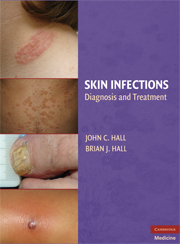Book contents
- Frontmatter
- Contents
- List of Contributors
- Acknowledgments
- INTRODUCTION
- TECHNIQUES IN DIAGNOSING DERMATOLOGIC MANIFESTATIONS OF INFECTIOUS DISEASES
- PRINCIPLES OF MANAGEMENT OF DERMATOLOGIC INFECTIONS IN THE SKIN
- PART 1 COMMON INFECTIONS
- PART II LESS COMMON INFECTIONS
- PART III INFECTIONS IN SELECTED ECOSYSTEMS
- PART IV INFECTIONS IN SELECTED PATIENT POPULATIONS
- 13 SKIN INFECTIONS IN HIV PATIENTS
- 14 INFECTIONS IN ORGAN TRANSPLANT PATIENTS
- 15 CANCER PATIENTS AND SKIN INFECTIONS
- 16 SKIN INFECTIONS IN PEDIATRIC PATIENTS
- 17 SKIN INFECTIONS IN THE ELDERLY
- 18 SKIN INFECTIONS IN ATHLETES
- 19 SKIN INFECTIONS IN DIABETES MELLITUS
- PART V INFECTIONS OF SPECIFIC SKIN-ASSOCIATED BODY SITES
- PART VI SPECIAL DISEASE CATEGORIES
- Index
15 - CANCER PATIENTS AND SKIN INFECTIONS
from PART IV - INFECTIONS IN SELECTED PATIENT POPULATIONS
Published online by Cambridge University Press: 08 January 2010
- Frontmatter
- Contents
- List of Contributors
- Acknowledgments
- INTRODUCTION
- TECHNIQUES IN DIAGNOSING DERMATOLOGIC MANIFESTATIONS OF INFECTIOUS DISEASES
- PRINCIPLES OF MANAGEMENT OF DERMATOLOGIC INFECTIONS IN THE SKIN
- PART 1 COMMON INFECTIONS
- PART II LESS COMMON INFECTIONS
- PART III INFECTIONS IN SELECTED ECOSYSTEMS
- PART IV INFECTIONS IN SELECTED PATIENT POPULATIONS
- 13 SKIN INFECTIONS IN HIV PATIENTS
- 14 INFECTIONS IN ORGAN TRANSPLANT PATIENTS
- 15 CANCER PATIENTS AND SKIN INFECTIONS
- 16 SKIN INFECTIONS IN PEDIATRIC PATIENTS
- 17 SKIN INFECTIONS IN THE ELDERLY
- 18 SKIN INFECTIONS IN ATHLETES
- 19 SKIN INFECTIONS IN DIABETES MELLITUS
- PART V INFECTIONS OF SPECIFIC SKIN-ASSOCIATED BODY SITES
- PART VI SPECIAL DISEASE CATEGORIES
- Index
Summary
The two basic components of cancer therapy have long been chemotherapy and radiation therapy. Both these modalities, especially chemotherapy, were based on the cytotoxic effect they exerted on cancer cells. Their cytotoxicity, of course, carried over to both rapidly dividing normal cells and nonmalignant host cells. The most commonly affected cells were those of the lymphatic and hematopoietic systems. Destruction of these cells, most notably the neutrophil, could leave the patient with less cancer, but it would also leave the patient with less immunity, and therefore, more susceptibility to infection. Death in these patients was frequently due to infection rather than malignancy.
Oncology has now progressed to the point that survival for extended periods of time can take place with control as opposed to eradication of the cancer. Although a patient is less immunocompromised with receptor blockers, monoclonal antibodies, tyrosine kinase inhibitors, antiangiogenic therapy, and therapies yet to be discovered, there is still immune suppression and a larger window of time for infections to develop. There is also a much larger number of patients for whom infection, not cancer, becomes the life-threatening event.
The seminal laboratory finding that is most often associated with these infections is decreased numbers of neutrophils. Also, most of these infections will occur when the neutrophil count is at its lowest. Improvement conversely occurs when the neutrophil count begins to return to normal. Prophylactic antibiotics are often used when the neutrophil count is drastically reduced.
Leukemia and lymphoma are more capable of interfering with neutrophil function and numbers. As a result, both of them are more likely to present with skin infections at the onset.
- Type
- Chapter
- Information
- Skin InfectionsDiagnosis and Treatment, pp. 206 - 210Publisher: Cambridge University PressPrint publication year: 2009



